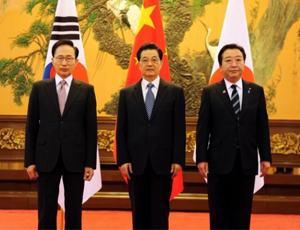 BEIJING – Despite political tensions between Japan and its East Asian neighbors, China and South Korea, officials from each of the three countries set aside their differences as they engaged in the fourth round of trilateral FTA talks in Seoul this week.
BEIJING – Despite political tensions between Japan and its East Asian neighbors, China and South Korea, officials from each of the three countries set aside their differences as they engaged in the fourth round of trilateral FTA talks in Seoul this week.
A China—Japan—South Korea FTA has been under negotiation since 2012. The current round of discussion commenced on Tuesday and will wind up tomorrow. State News Agency Xinhua reported that the Chinese delegation said the talks will “[focus] on modalities of tariff reduction, the way of opening service trade, investment and certain range and fields of the agreement.”
Though South Korea’s Trade Minister Yoon Sang-jick has said that a major breakthrough would be unlikely, the negotiations were moving forward. Indeed, the fact that the dialogue is taking place at all is encouraging, given the multitude of events that have tested the relationships Japan has with its East Asian neighbors in recent times.
For one, the ever-fragile relationship between China and Japan has been strained by the ongoing dispute over the Diaoyu/Senkaku islands.
Japanese Prime Minster Shinzo Abe’s visit to the Yasukuni Shrine last December further increased the animosity held by China and South Korea towards Japan, as the shrine honors convicted war criminals alongside other soldiers who died in World War II.
RELATED: Understanding China’s Free Trade Agreements
Since the Yasukuni Shrine visit, China has stated it would not hold government-level meetings with Japanese officials, especially with Prime Minister Abe. It further approved two national days to mark the 1937 Nanjing Massacre and the Japanese’s surrender in World War II, a move that risks antagonizing the Japanese.
While the Japanese government declined to comment on China’s new national days, it announced last week it would review an apology made in 1993 to “comfort women” forced into wartime sex slavery. Japan risks angering and further alienating China and, in particular, South Korea as it moves to review the testimony of 16 South Korean women on which the apology was partly based.
Yet, against this background of renewed political hostility, the economic benefits of the proposed trilateral FTA have caused the countries to set aside their political agendas with a view to strengthening economic ties. China and Japan have the two largest economies in Asia, while South Korea’s economy is the fifth largest (behind India and Russia). Combined, the three East Asian countries’ economies totaled US$15.3 trillion in 2012, according to the World Bank’s estimates. This makes up over one fifth of the world’s GDP, and is not far behind the dominating economies of the EU (US$16.7 trillion) and NAFTA (US$19.2 trillion).
RELATED: Global Impact of a China-Japan-South Korea Free Trade Agreement
In terms of trade, similarly, the combined exports and imports of China, Japan and South Korea are impressive. In 2012, China, Japan and South Korea’s combined exports and imports reached US$6.6 trillion, accounting for 18.2 percent of world trade, according to the UN Statistics Division.
According to the WTO’s Trade Profiles, China was the primary trading partner for both Japan and Korea in 2012. China accounted for around a fifth of both island nations’ external trade in goods, with total bilateral trade in goods in 2012 valued at US$332 billion for Japan and US$215 billion for Korea.
Between Japan and South Korea, the economic ties are also strong. Bilateral trade between the two nations reached US$105 billion in 2012, and both countries are among each other’s top five trading partners.
From China’s perspective, both Japan and South Korea are significant trading partners: Japan is China’s single largest source of imports and third largest export country; South Korea is China’s second largest source of imports and fourth largest export country.
China is also in the process of negotiating a separate bilateral FTA with South Korea, for which the tenth round of talks will commence later this month.
You can stay up to date with the latest business and investment trends across Asia by subscribing to Asia Briefing’s complimentary update service featuring news, commentary, guides, and multimedia resources.
Related Reading
 An Introduction to Tax Treaties Throughout Asia
An Introduction to Tax Treaties Throughout Asia
In this issue of Asia Briefing Magazine, we take a look at the various types of trade and tax treaties that exist between Asian nations. These include bilateral investment treaties, double tax treaties and free trade agreements – all of which directly affect businesses operating in Asia.
China-Japan-South Korea Sign Trilateral Agreement and Launch FTA Talks


